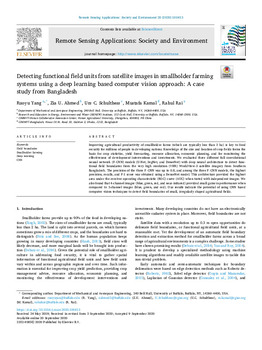Mostrar el registro sencillo del ítem
Detecting functional field units from satellite images in smallholder farming systems using a deep learning based computer vision approach: a case study from Bangladesh
| Creador: | Ruoyu Yang |
| Creador: | Ahmed, Z. |
| Creador: | Schulthess, U. |
| Creador: | Kamal, M. |
| Creador: | Rai, R. |
| Año: | 2020 |
| URI: | https://hdl.handle.net/10883/20982 |
| Formato: | |
| Lenguaje: | English |
| Editor: | Elsevier |
| Copyright: | CIMMYT manages Intellectual Assets as International Public Goods. The user is free to download, print, store and share this work. In case you want to translate or create any other derivative work and share or distribute such translation/derivative work, please contact CIMMYT-Knowledge-Center@cgiar.org indicating the work you want to use and the kind of use you intend; CIMMYT will contact you with the suitable license for that purpose |
| Tipo: | Article |
| Lugar de publicación: | Amsterdam (Netherlands) |
| Volumen: | 20 |
| DOI: | 10.1016/j.rsase.2020.100413 |
| Palabras Claves: | Field Boundaries |
| Palabras Claves: | Smallholder Farming |
| Palabras Claves: | Deep Learning |
| Palabras Claves: | Convolutional Neural Networks |
| Descripción: | Improving agricultural productivity of smallholder farms (which are typically less than 2 ha) is key to food security for millions of people in developing nations. Knowledge of the size and location of crop fields forms the basis for crop statistics, yield forecasting, resource allocation, economic planning, and for monitoring the effectiveness of development interventions and investments. We evaluated three different full convolutional neural network (F–CNN) models (U-Net, SegNet, and DenseNet) with deep neural architecture to detect functional field boundaries from the very high resolution (VHR) WorldView-3 satellite imagery from Southern Bangladesh. The precision of the three F–CNN was up to 0.8, and among the three F–CNN models, the highest precision, recalls, and F-1 score was obtained using a DenseNet model. This architecture provided the highest area under the receiver operating characteristic (ROC) curve (AUC) when tested with independent images. We also found that 4-channel images (blue, green, red, and near-infrared) provided small gains in performance when compared to 3-channel images (blue, green, and red). Our results indicate the potential of using CNN based computer vision techniques to detect field boundaries of small, irregularly shaped agricultural fields. |
| Agrovoc: | FIELDS |
| Agrovoc: | BOUNDARIES |
| Agrovoc: | SMALLHOLDERS |
| Agrovoc: | MACHINE LEARNING |
| Agrovoc: | NEURAL NETWORKS |
| ISSN: | 2352-9385 |
| Revista: | Remote Sensing Applications: Society and Environment |
Ficheros en el ítem
Este ítem aparece en la(s) siguiente(s) colección(ones)
-
Sustainable Intensification
Sustainable intensification agriculture including topics on cropping systems, agronomy, soil, mechanization, precision agriculture, etc.

